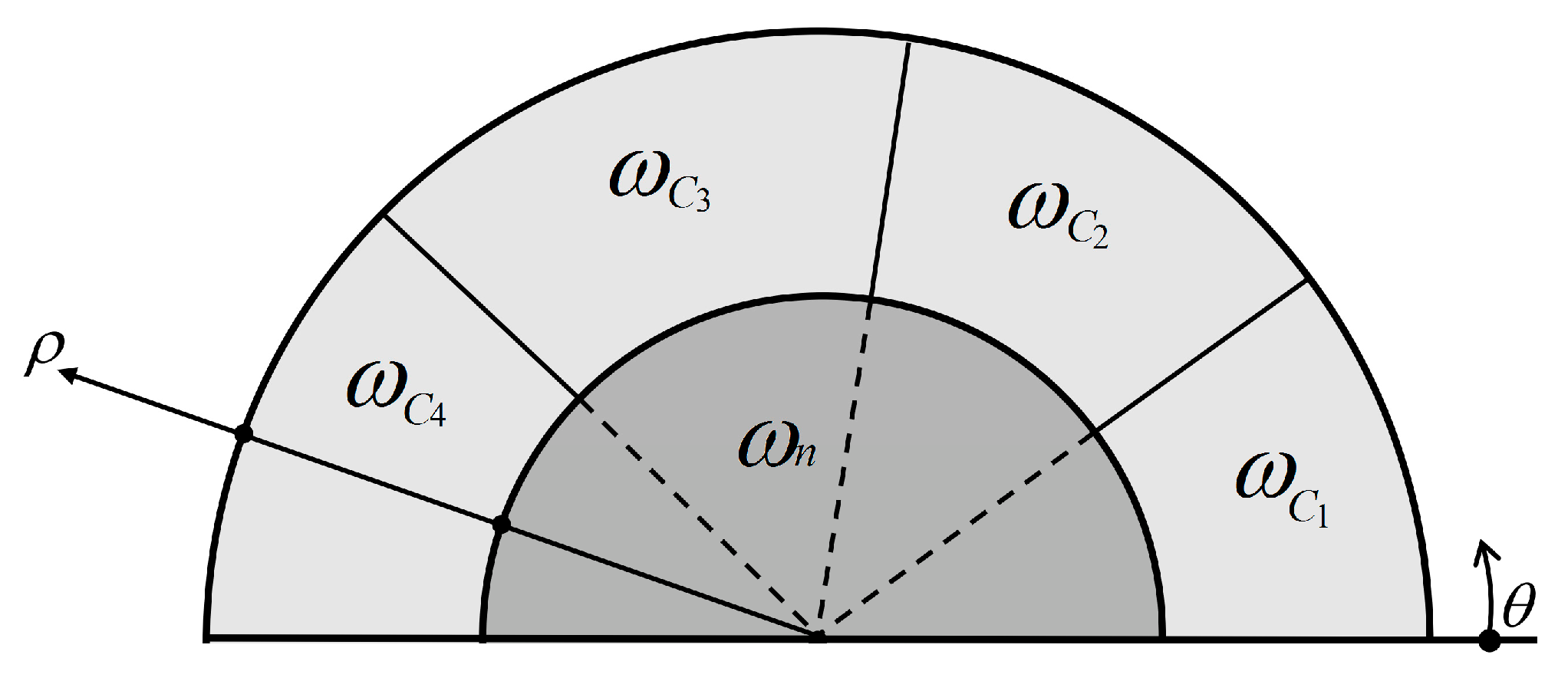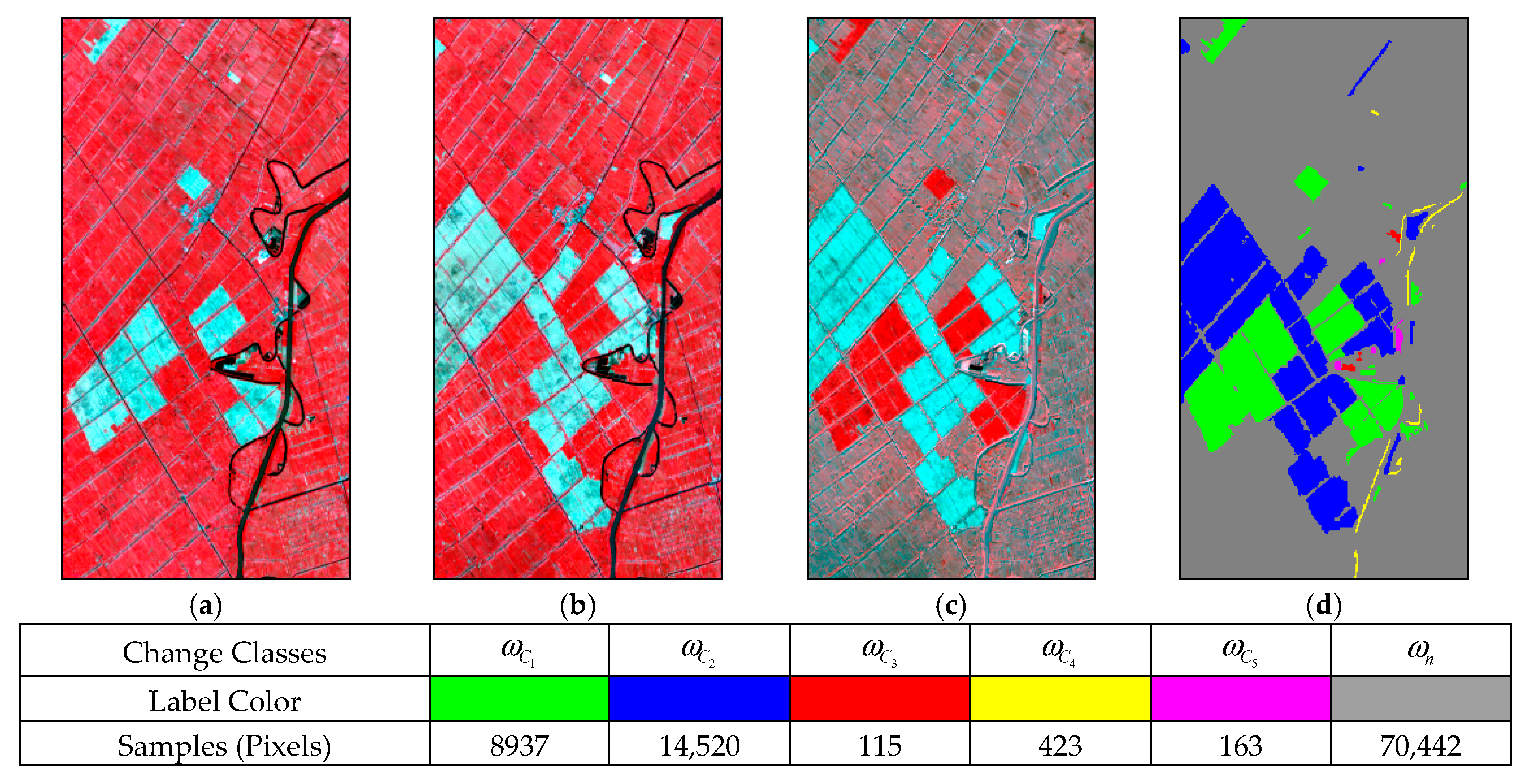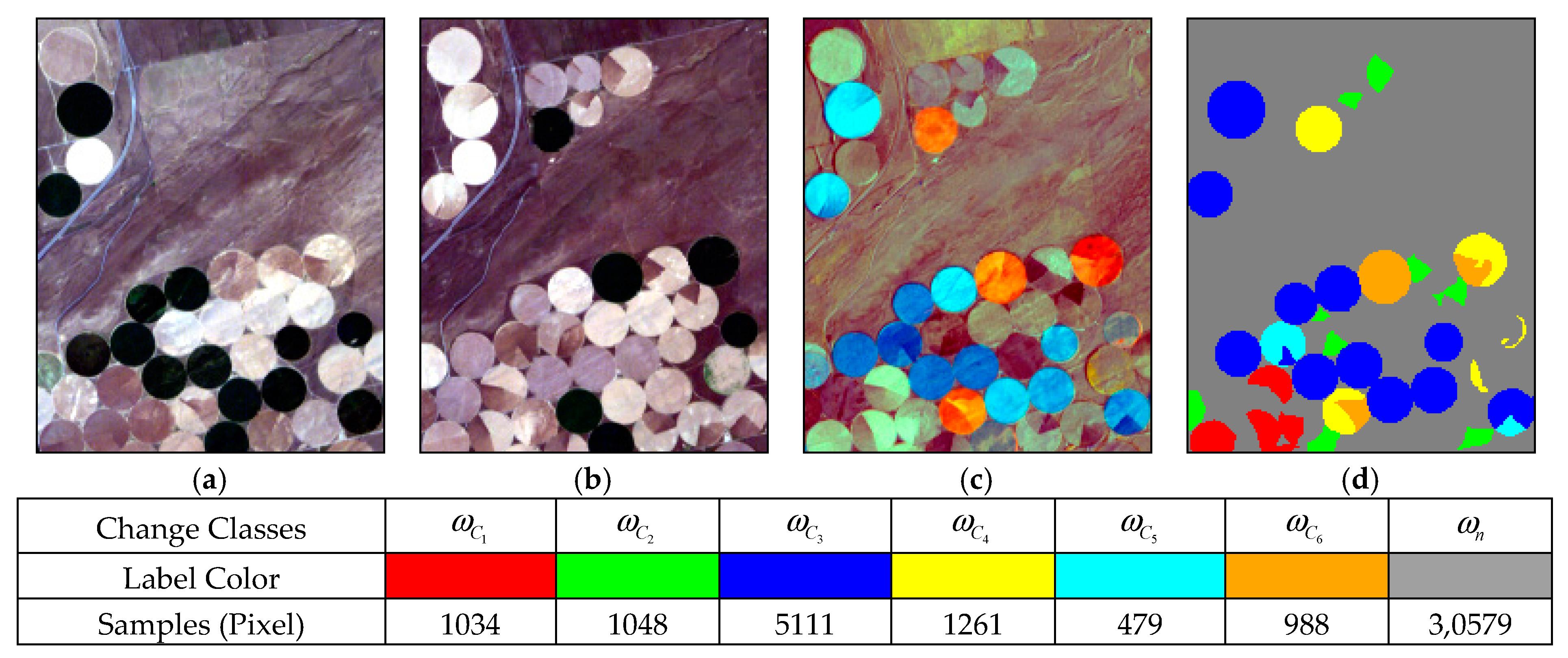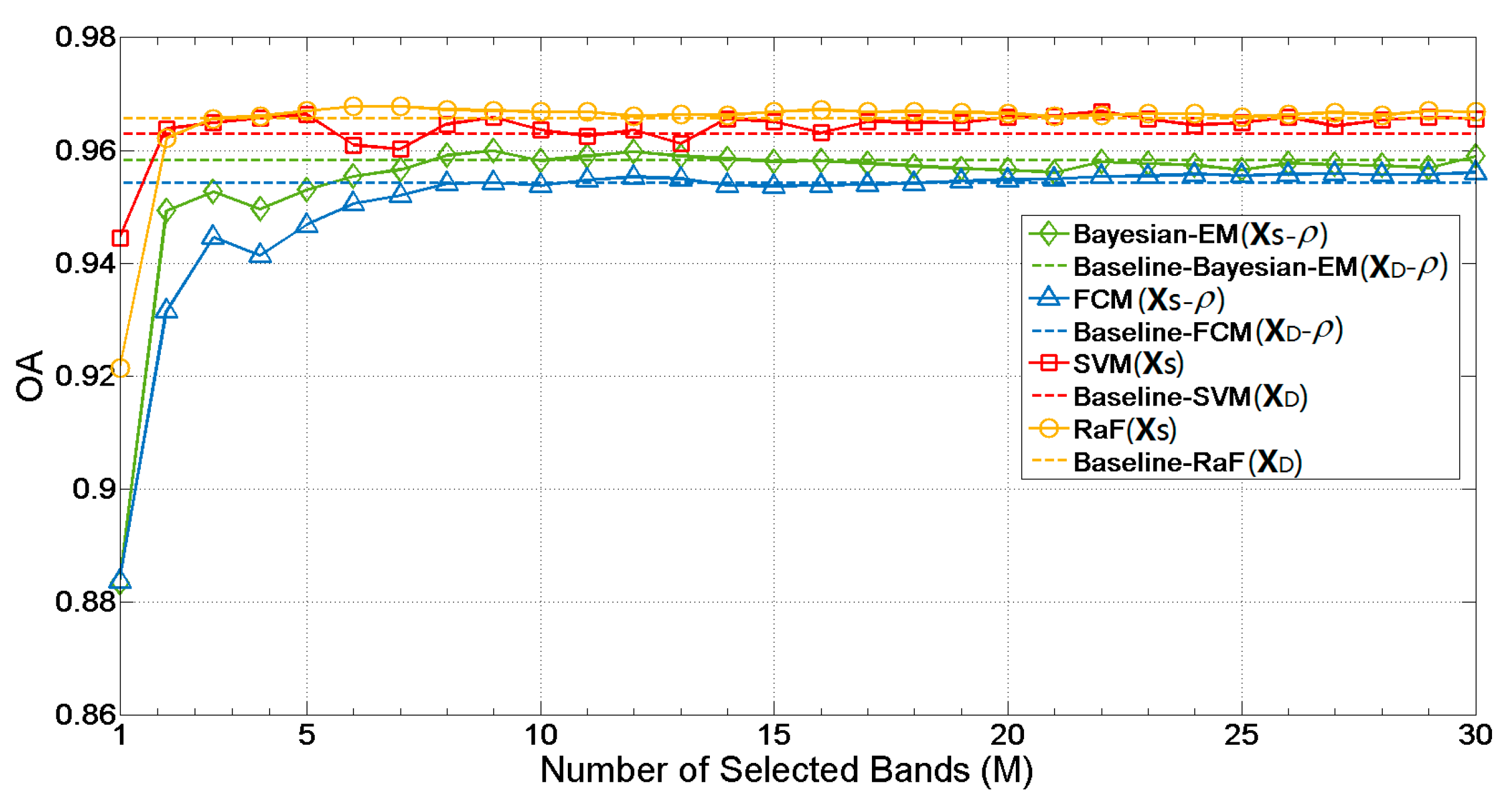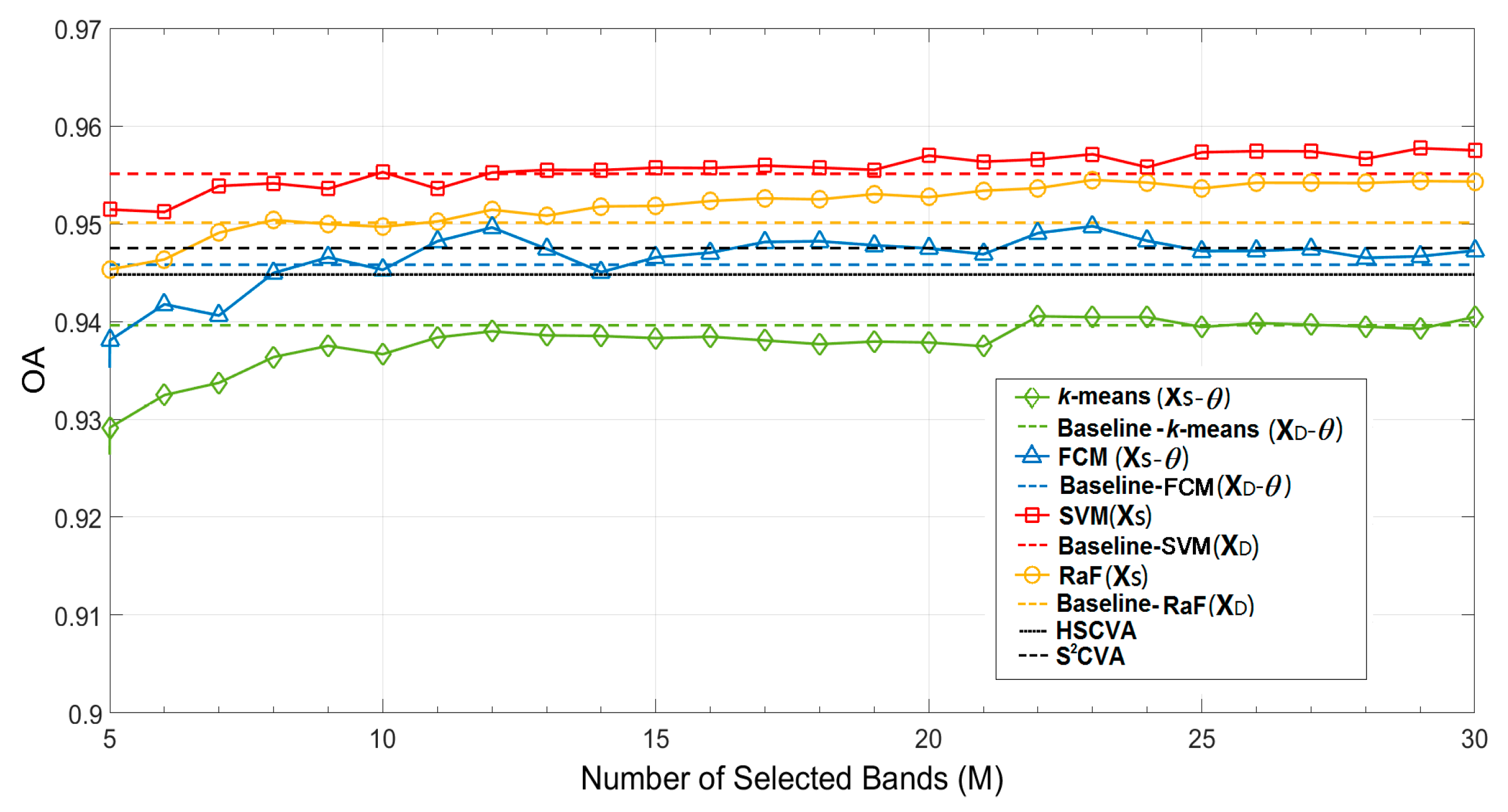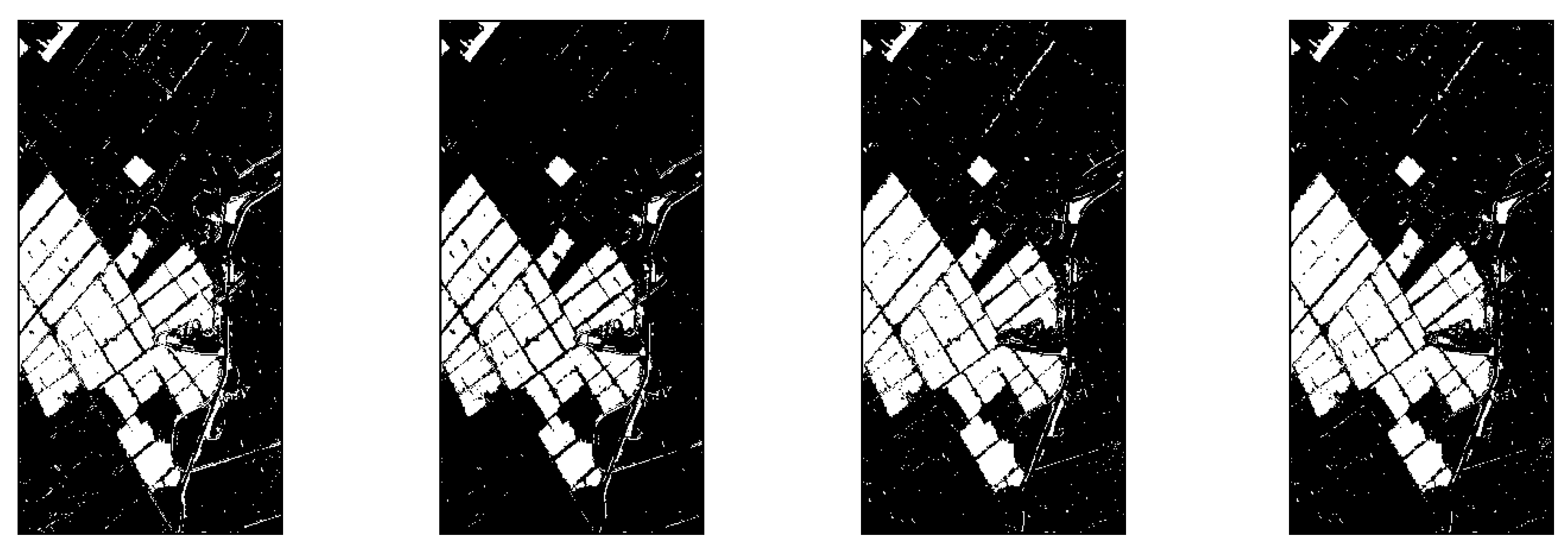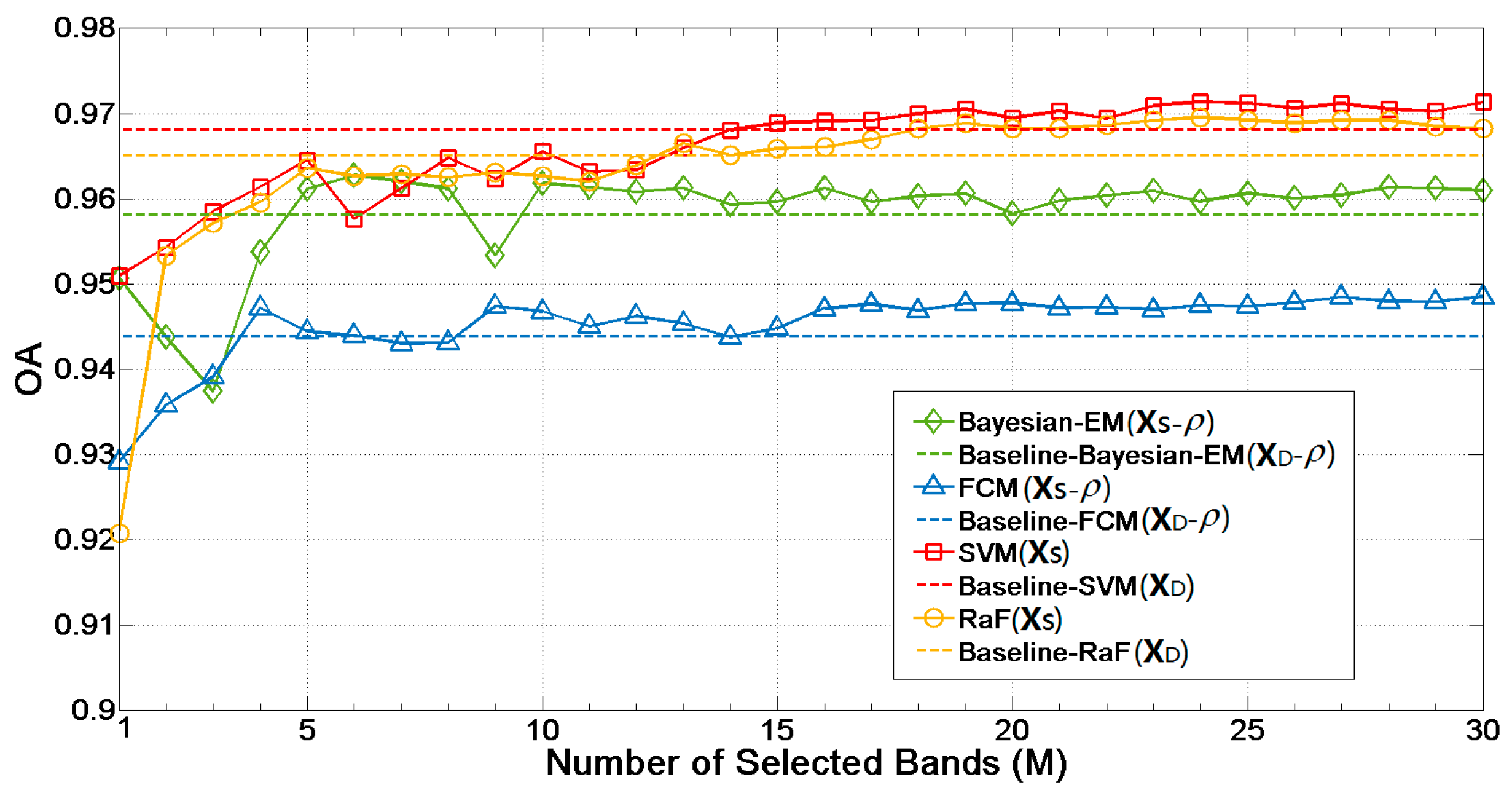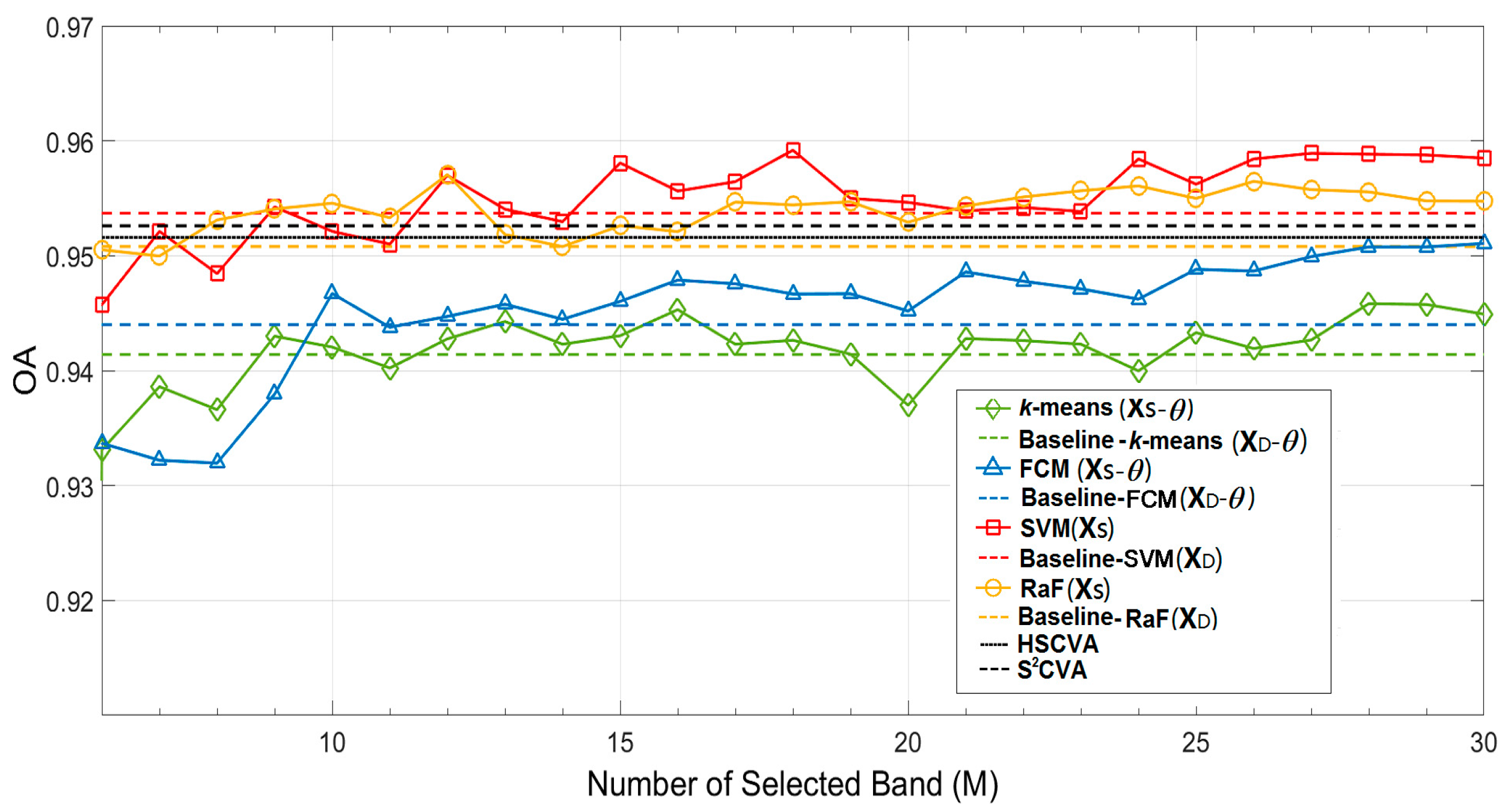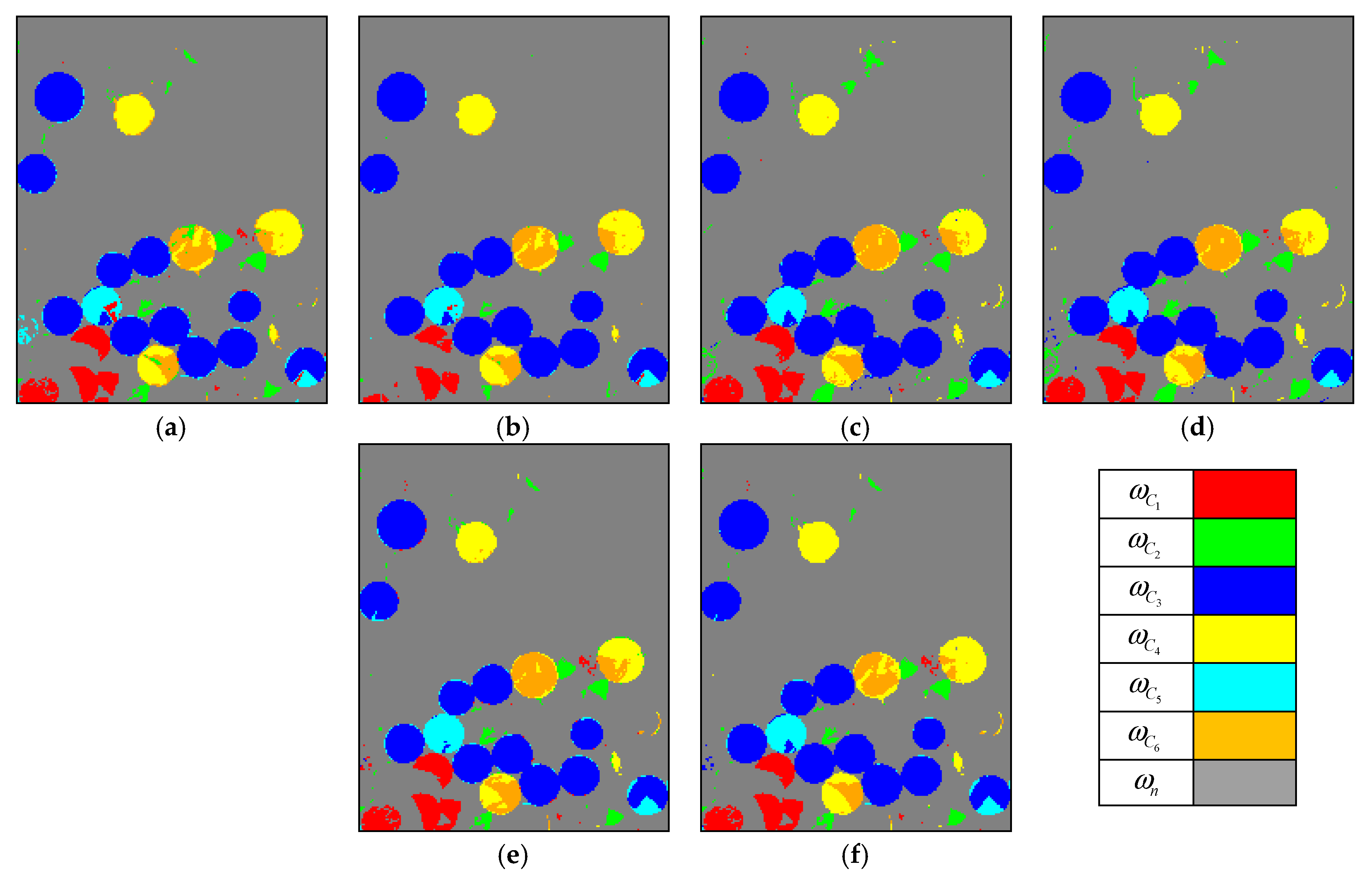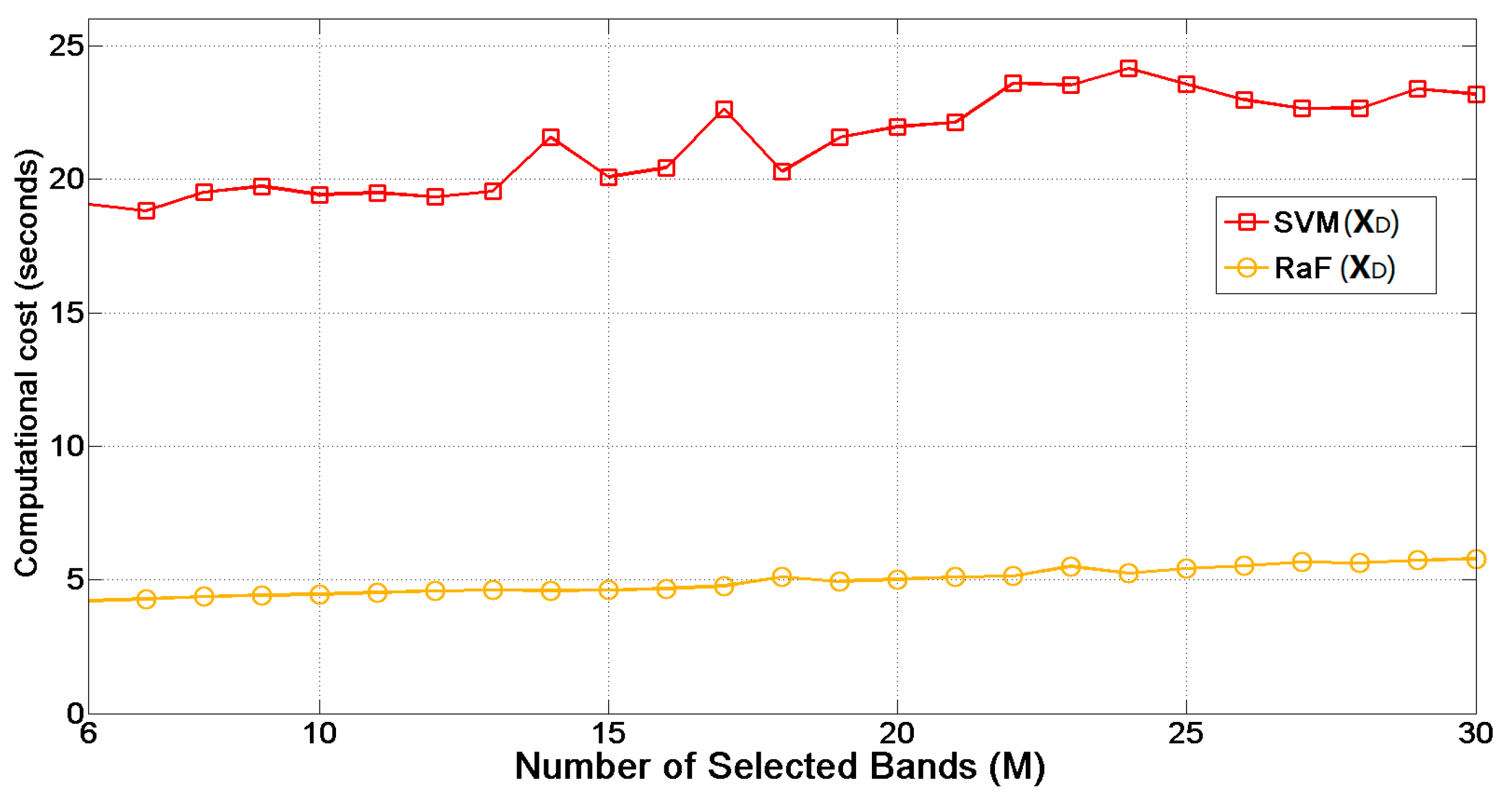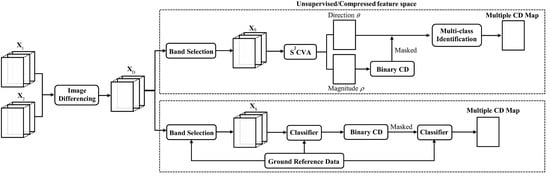1. Introduction
Next-generation hyperspectral sensors onboard airborne and spaceborne crafts can acquire hyperspectral images (HSIs) through dense spectral sampling (e.g., 1–10 nm) over a wide wavelength spectrum (e.g., 400–2500 nm) [
1]. Hyperspectral imaging has becoming increasingly popular and important in various applications (e.g., environmental monitoring, food safety control, mineral discovery, and the military). In particular, for Earth observations, it provides materials’ spectral signatures at a fine and sophisticated level. Different from the traditional multispectral images, which characterized coarse spectral resolution in several broad spectral channels (i.e., bands), the detailed spectral sampling in hyperspectral imaging results in hundreds or even thousands of contiguous spectral bands that dramatically increases data storage volume and the ensuing data processing complexity. The high dimensionality may lead to the so-called “curse of dimensionality” or “Hughes phenomenon”, i.e., with a fixed number of training samples, the predictive power of a classifier reduces as the dimensionality increases [
2,
3]. Moreover, the adjacent bands are highly correlated. Such redundant information may affect how the user-interested information has been represented and detected to a great extent. The aforementioned challenges have raised many issues about handling hyperspectral data in different remote sensing tasks, e.g., classification, target detection, etc.
Dimensionality reduction (DR) techniques have been intensively investigated and used in hyperspectral image analysis [
3,
4,
5,
6,
7,
8,
9,
10,
11,
12,
13,
14,
15,
16]. Usually, as a kind of pre-processing method, DR techniques are able to reduce very high-dimensional data to a manageable low-dimensional space where data analysis can be performed in a more effective way [
4]. By reviewing the literature, two main categories of DR methods can be summarized: transformation-based DR and band selection-based DR. The former transforms the original data into a compact feature space and analyzes the major components. Approaches such as Principle Component Analysis (PCA) [
5], folded-PCA [
6], Minimum Noise Fraction (MNF) [
7], Independent Component Analysis (ICA) [
8], Orthogonal Subspace Projection (OSP) [
9], etc., have been successfully integrated into HSIs applications. The latter searches for an appropriate subset of original bands according to certain criteria and retains the physical meaning of pixels’ spectral response. In this context, Du and Yang [
10] proposed an unsupervised band selection algorithm based on band similarity measurement, employing the idea from the distinctive pixel identification in endmember extraction. Yang et al. [
11] designed a supervised and efficient band selection approach based on minimum estimated abundance covariance (MEAC) by using the known class signatures. Yang et al. [
12] proposed a semi-supervised feature-metric-based affinity propagation (FM-AP) band selection technique, which takes advantage of the relevant component analysis to build a FM for assessing the class discrimination capability of single band and measuring the spectral correlation among bands. Patra et al. [
13] developed a rough-set-based supervised band selection approach to select the informative bands having higher relevance and significant values. Jia et al. [
14] developed an enhanced fast density-peak-based clustering (E-FDPC) for the unsupervised band selection task in HSI, and an isolated-point-stopping criterion was developed to automatically determine the appropriate number of bands to be selected. Yuan et al. [
15] proposed a group-wise band selection framework. It evaluates the representativeness of band combination based on a multi-task sparsity pursuit criterion, where a smart yet intrinsic descriptor and a computational evolutionary strategy are used. Other new techniques such as manifold learning [
16] and sparse coding [
17,
18] represent new trends to analyze and provide a solution to a multi-feature dataset, which have the potential to contribute to the considered BS topic in practical applications. Existing DR methods are mainly focused on solving a classification or target detection problem in a single-time HSI [
3,
6,
10,
11,
12,
13,
14,
15,
16]. To the best of our knowledge, no work has been done to investigate in detail the DR technique and its impact on the multi-temporal hyperspectral images change detection (HSI-CD) task. This is very important due to the high dimensionality of hyperspectral images, and is also applicable to feature selection for CD enhancement in other types of datasets, i.e., Polarimetric Synthetic Aperture Radar (PolSAR) or multispectral images, with an increased number of expanded or extracted features.
Change detection (CD) is one of the most important remote sensing applications. Technically, it is the process identifying changes occurred between two (or more) images over a same geographical area at different observation times [
19,
20]. In the past decades, due to the availability of multi-temporal optical remote sensing datasets, CD tasks were intensively conducted on multispectral images [
21,
22,
23,
24,
25,
26,
27,
28]. Recently, the available multi-temporal HSIs in data archive have promoted the extension of CD research at a finer level. By considering the CD application purpose, these techniques can be mainly divided into two groups for binary CD and multiple CD [
29]. Binary CD methods consider only the presence/absence of changes, without analyzing the possible different land-cover class transitions. Studies on aspects such as transformation-based CD techniques, e.g., covariance equalization and cross covariance [
30,
31], multivariate alteration detection (MAD) [
32], Temporal-PCA (TPCA) [
33], ICA [
34], etc. and spectrum analysis-based CD methods, e.g., change analysis after radiometric normalization [
35], target-background separation based on orthogonal subspace projection [
36], etc. can be found to address the binary CD problem in HSIs. For the more challenging multiple CD, it aims to detect the changes, but also to identify different kinds of changes. Liu et al. [
1] proposed a coarse-to-fine hierarchical spectral change clustering approach for detecting changes having spectral variations at different significance levels. Liu et al. [
37] designed a semi-supervised sequential spectral change vector analysis (S
2CVA) approach for discovering, identifying, and discriminating multiple changes according to a sequence of adaptive change projections. Liu et al. [
38] investigated the spectral–temporal mixture properties in multi-temporal hyperspectral images, and proposed an unsupervised multi-temporal spectral unmixing model to address the multiple CD problem at a subpixel level. However, these works either simply utilized the full dimensionality of the feature space [
30,
31,
32,
33,
35,
36,
38], or exploited a complex hierarchical structure of the changes [
1,
34,
37], ignoring the potential capability of solving the HSI-CD problem in a reduced low-dimensional feature space.
In this paper, we address for the first time the challenging HSI-CD problem in a low-dimensional feature space by using band selection-based DR (BS-DR) algorithms. The most informative band subset is investigated for change representation and discrimination in an unsupervised and supervised fashion, respectively. In particular, the following issues are analyzed in detail: (1) the estimated number of changes; (2) the binary CD; (3) the multiple CD; (4) the estimated optimal number of selected bands; and (5) computational efficiency. The main contribution of this paper is, through the design of complete evaluation procedures and the obtained experimental results, to investigate the feasibility of addressing the considered high-dimensionality HSI-CD task in a reduced feature space without losing the change representative and discriminable capabilities of a detector. Note that the proposed method is also potentially applicable to practical CD applications in multi-temporal remote sensing images after having high-dimensional features, such as generated spectral, textural features, and the stacked PolSAR features derived from different coherent and incoherent decomposition models. Two multi-temporal hyperspectral Hyperion datasets are used to validate the proposed approaches. Experimental results demonstrate the effectiveness of using selected band subsets to meet or even exceed the CD performance of all original bands, and a comparable performance is observed when comparing with two state-of-the-art reference methods.
The rest of this paper is organized as follows.
Section 2 describes in detail the proposed HSI-CD approaches based on BS-DR and the evaluation procedure.
Section 3 introduces the hyperspectral datasets and reports and discusses the experimental results. Finally,
Section 4 draws conclusions.

